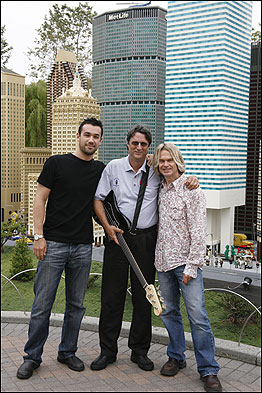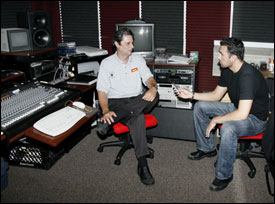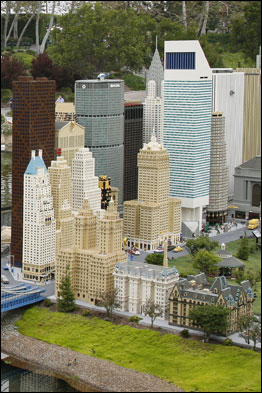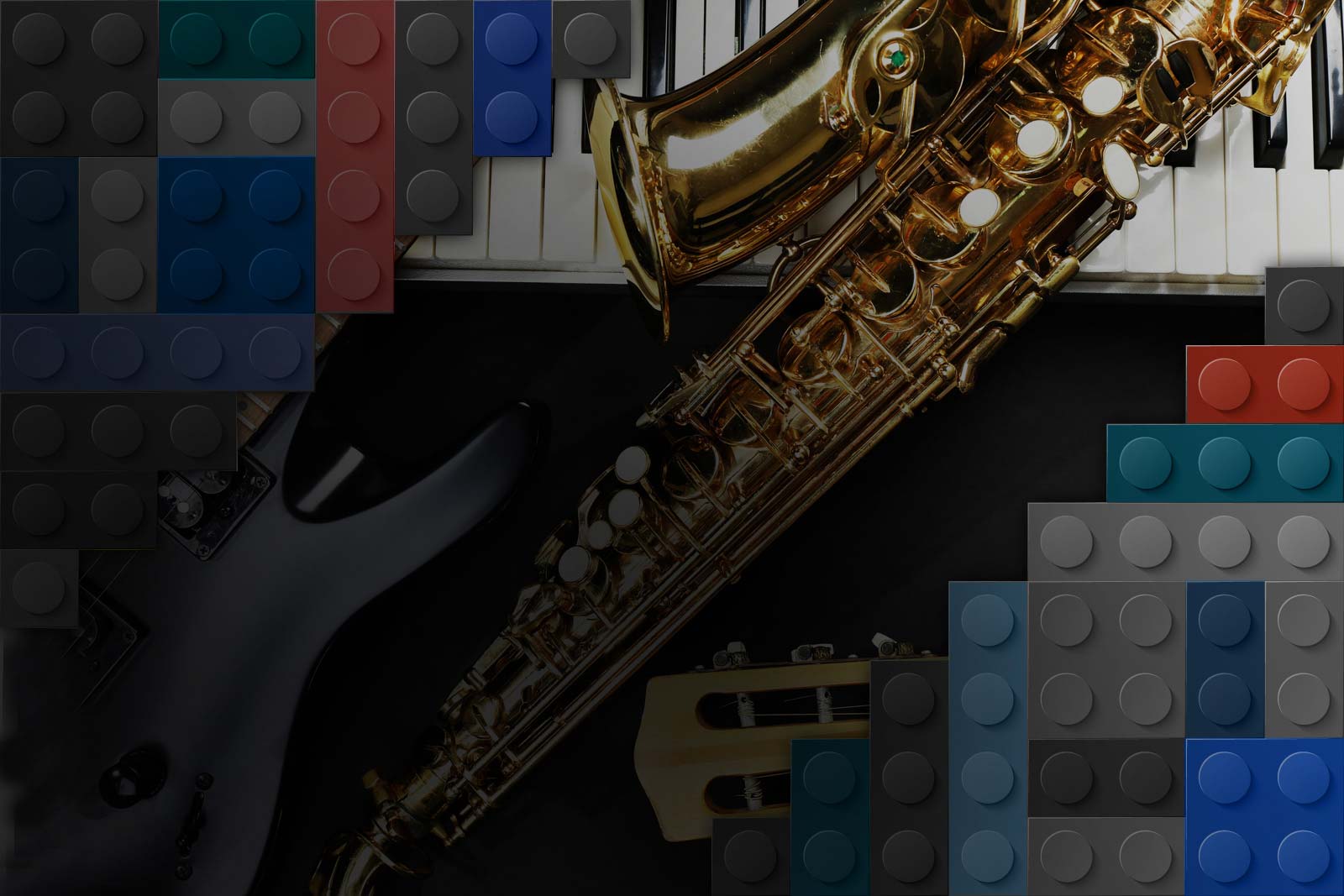This VEGAS Creative Software prize drawing winner is also a VEGAS and ACID Pro power user

As part of the promotion of a collection of loops, Tony Franklin, Fender, and VEGAS Creative Software gave away a Tony Franklin Fender bass at the National Association of Music Merchants convention in Anaheim in January 2006. The contest winner, Paul Beach, is a former professional musician who toured with The Mamas and the Papas, The Association, and many others. Paul now works for LEGOLAND theme parks as a Technical Specialist. In this capacity, Paul is responsible for the development of all media content used in the LEGOLAND parks around the world, including show and attractions content, guest services media, and orientation and training materials. As a longtime devoted user of VEGAS Creative Software, we wanted to find out how Paul uses ACID Pro and VEGAS software, as well as various loop collections to create sound design for LEGOLAND parks all over the world.
VEGAS Creative Software: So you created this position, basically, and you provide, in a nutshell, all the audio editing and audio design for the different components of the park, whether it’s triggered by something on a ride or whether it’s music to have. Do you compose original music for the park as well?
Paul Beach: I’ve done some in ACID mostly. I don’t have time to really get serious about hiring live players. I did do that on one project for one of the shows we have here called “The Big Test.” It was actually an existing piece of music that I rearranged to make it more updated from what it was. They rhythm section was really weak on it and I thought about just putting an ACID loop underneath it and I worked with it and I thought you know what, it really needs to be done top to bottom. So I rerecorded all that up at my studio at home because at the time they were rebuilding the electrical substation here and there were jackhammers and stuff going off so there was no way! So we ended up recording live instruments for that and then brought people in to do some vocal overdubs, kind of sing-songy, almost like a rap kind of thing.
VCS: So when you said you started here three weeks before the park opened it was around 1999 and when did this position kind of actualize itself?
PB: It was kind of gradual, but as far as it becoming an official position, right around the time I was lucky enough to get married, so 2001. I actually came here looking for a job as a bass player.
VCS:Do they have live performances here?
PB: No. But they had this position available on the show deck and they asked if I’d ever done a live show and I said yeah, sure. When I was on the road, we would go in the studio and record things for television shows and I was so fascinated by how these guys did everything and I ended up hanging out with the engineers and asking them if I could watch them mix. I asked them a million questions and got really interested in that so I took some engineering courses and set up a small studio in my house. I started doing some demos out of my house and other stuff that got some local radio airplay. That kind of led to what I do here because it all kind of fell together naturally, that’s why I still have a home studio; I had that first before I had this, so I already knew how to do it. It’s not set up with your standard patch bay like you see in a big studio but I designed it to fit our needs for the park with a minimal amount of cash outlay.
VCS: And you’ve been using VEGAS since . . .
PB: Since before it actually existed. I did a beta version of it first. Then when it went to video, 3.0, I went oh my gosh this is great.
VCS:Typically, what kind of parameters do they give you when a new project comes up?
PB: For example, right now we’re adding this new ride at the top of the park. There’s no video involved with that but we’re doing a lot of work in VEGAS on that. That’s going to be opening in the middle of June.
VCS:What kind of guidelines did they give you?
PB: Sometimes they give me an exact script. For example, a safety spiel on a ride has to have all these things that the Department of Health and Safety requires so we have real specific dialogue that we need for that. Other times, we make up things on the fly. We have a miniature golf course up here, another attraction, where they wanted little gophers talking to each other, kind of like “Caddyshack” I guess, so we made up these characters and just sat there and had some fun, just stream of consciousness, made up really bad golf jokes; “How many balls do you think you’ve seen down here in the basement today? Four.” Silly stuff like that. Making fun of people’s shoes as they walk by.
VCS:So there was a lot of freedom within the parameters but then you’d come up with stuff and sometimes they’ll love it and sometimes they’ll not, is that the case?
PB: You know what? I’ve never had anybody turn something away. They’ll say we need to change this a little bit because this character is female instead of male, something like that. After working here for awhile, you kind of know what works and what doesn’t. Really we’ve been given free rein.
VCS: Obviously, they’re going to give you certain things to do and certain rides have certain needs. But has anything ever had its genesis in here in the studio where you say ‘We did this, this is really cool, you guys should design something around this?’
PB: The beginning, the area of the park that’s the main entrance, they just had background music playing on a CD player and I said ‘Why aren’t we cross-promoting the park? Let’s do some sound effects, let’s do some Hey kids, come see Chief Stern at the Big Test.’ Or Kevin Johnson, the ventriloquist and have him use voices and talk about the show, get people’s minds outside of that immediate area. By the same token, cross-promoting within the two venues that have video screens. So VEGAS is used for that, VEGAS is used for the audio we did for the beginning, the music and the voiceovers and we write our own dialogue for that.
VCS: You and . . .
PB: Depends. Kevin Johnson and I do most of it, probably ninety percent of it really. Anytime something comes up when there’s an event we look at it and say ‘O.K., what can we do to present this in the best light to the public?’ Most of the time we’re so busy that we meet the minimum requirements, but once in awhile we have time to actually get creative with it, we could do this, we could do that.
VCS: Have they actually built a character or piece because of something you created?
PB: I don’t think so. They should, though. UM2: Actually, that’s not true. This summer, we have a brand new Lego model that’s an animatronic skull that’s going to be used in one of our shows and that was a concept that we came up with in-house and they created the model. That’s one of the first examples I can think of.
VCS:That’s nice because it’s obviously a big, organized business, but you still have a lot of freedom and you obviously have a lot of fun with it, too.

PB: We have a lot of autonomy but part of the reason we’ve been successful is that we’re always looking forward, what are the future needs and what can we do to be proactive about them. I try to go to them with ideas. I try to be reasonable about it, saying we could do it for this, and it’s not going to cost you, either.
VCS:So is this, the freedom here and the set-up and the venues you’ve set up for yourself brought back around to your original love, which was playing bass and playing music? And how did you get to NAMM?
PB: Man, I’ve been going to NAMM for thirty years. I always find a way of going. NAMM headquarters is right behind us.
VCS:So being a bass player you were tuned into him (Tony Franklin), and then being a VEGAS guy ever since, so what did you think when you saw his library and the artist integration concept?
PB: I thought that was a cool idea. Usually I end up playing my own bass parts against the drum parts because the bass parts that are on the loop up to that point didn’t always groove the way I wanted them to. The first thing I saw was that bass, actually, honestly. Whoa, that’s nice. Woo hoo. ‘There’s a drawing? Okay!’ I didn’t think anything more about it, then months later Tony calls me up. In fact, I thought it was the ventriloquist. We are always messing with each other. It’s just part of our relationship. When I got your phone call I was immediately thinking of ways to get back at him. He did pretty good on the English accent, because he always kind of researches everything he does before he does it, right? Alright, Kevin, it’s on, dude. And then as it went on, you gave the phone number and the email address so I went online to look and thought maybe this is real. I thought alright, I’ll call the number. I was ready for anything. I thought that’d be cool if I won it but I knew Kevin was there. I knew he was there and I just knew he was so messing with me. And then when I talked to you I went wow, it really is you and it sounded like your voice, but you know Kevin’s good with voices. Then when I actually talked to you I went oh my God, this is real!
VCS:Excellent.
PB: When I first started I didn’t even know about loops, I just knew that Sound Forge that I bought for like $95 or something from Sonic Foundry was a little tough for me to deal with in terms of me wanting to layer sounds, create sound effects that they wanted for opening a new ride or whatever. VEGAS Audio 2.0 came out right then and I went oh that’s for me. Then I put together a proposal of a project we had coming up, here’s what you’re going to pay for it, here’s what we’d pay for it if we did it here with existing equipment we have on site. I said all I need is a computer from IT, if they have a castoff computer that nobody’s using I’ll take it, I’ll make it work. I ended up having to buy a little bit of RAM for it, that was it, and a sound card, nothing fancy at all. And then I got to working on VEGAS 2, and I’d done everything on tape up to that point and I just looked at the editing and being able to move everything around and I thought this is so fast and so easy and I stayed up until like 2 o’clock every morning, ‘I can do this, I can do that.’ I got all excited about it.
VCS:What was the first production, what was that?
PB: It was for the opening of the Technic coaster on the other side of the park. They wanted to put a bunch of music, they wanted to have crossfades, they wanted to have everything specific to that type of environment. They wanted a sound effect for starting the ride up. I have this Hollywood Edge sound effects library up here and I start pulling things off. I found this sound that I pulled that I didn’t like and I didn’t realize that I was getting into sound design. I just thought ‘Hey, I bet if I put this together and do that and I can bend the pitch on it,’ and I started doing all these things and I had like seven or eight layers on this initial sound effect and it ended up being very effective. At the time I was a show technician here and long story short, I proposed we put in our own facility here. We don’t really have much money because most of the stuff was cast-offs from other shows. They agreed to buy a computer, they agreed to buy the sound treatment, everything else came from an office that wasn’t being used.
VCS:Soon pays for itself, though.
PB: Absolutely. Then I did a few projects and I was still working as a technician. Then I proposed that I go fulltime, because I could see the work piling up, I saw a need with maintenance because the one guy that did know audio in the park left. So these guys over there were coming to ask me how do we do this, how do we do that, so I went to the operations manager and said look we can do this all ourselves. Can we create a position for doing just that. I said here’s what we’ve saved already on these two projects alone over a period of three months, it was over $75,000 that we’d saved.
VCS: That speaks for itself. Now, you do video stuff as well, but you have been using VEGAS since before it was a video editor, when it was an audio editor. So do you do your audio editing primarily in VEGAS for non-video needs?
PB: For all of our fireworks soundtracks, we use VEGAS for that, we use it for all of our shows, for the soundtracks for the shows. . .
VCS:And how do you use ACID? Do you at all for any of these park needs?
 PB: Yes. A real recent example would be this new show that’s coming, Spellbreaker, the 4-D movie, everything that’s in that show aside from the main content was created in ACID or in VEGAS. Some of the original content wasn’t but all the editing stuff was done then rendered for that format. They were installing this movie in the other parks in England, in Denmark, and in Germany, and they were not showing any kind of pre-show video. In fact, that was one of the things I promoted to them, was why aren’t we showing something before our main show? That we can promote? When we first started it was just LEGOLAND in general then I said let’s cross-promote the park, the different shows and right now it’s mainly the shows but it can also be modified very quickly for any kind of promotional or special event that comes up. You can do whatever you want. We have enough talent here in the park that we can do most of it right here in this room. We can have it in place that day or the next day. So I used ACID to do the background music for that, in fact I used some of the stuff you guys were giving away at the show for the ACID Planet contest, the artist integrated series, I used three or four of those loops, actually. I was able to adjust the music and adjust the video back and forth. I did the primary composing part in ACID but rather than going back to ACID and adjusting anything beyond that point, I had a time I knew I had to work with, five minutes, I got a rough idea of how I wanted to edit the video then I got the music sitting right at five minutes then I went back and changed the music so it hit on one of the next section coming up then I moved sections around, changed styles of music, for example there’s an attraction over in the Denmark park that’s a western theme so I went straight into the Country… So used some of your tracks underneath it, combined them and went straight into that, then wove it back to get back into the park and went back to the original groove .
PB: Yes. A real recent example would be this new show that’s coming, Spellbreaker, the 4-D movie, everything that’s in that show aside from the main content was created in ACID or in VEGAS. Some of the original content wasn’t but all the editing stuff was done then rendered for that format. They were installing this movie in the other parks in England, in Denmark, and in Germany, and they were not showing any kind of pre-show video. In fact, that was one of the things I promoted to them, was why aren’t we showing something before our main show? That we can promote? When we first started it was just LEGOLAND in general then I said let’s cross-promote the park, the different shows and right now it’s mainly the shows but it can also be modified very quickly for any kind of promotional or special event that comes up. You can do whatever you want. We have enough talent here in the park that we can do most of it right here in this room. We can have it in place that day or the next day. So I used ACID to do the background music for that, in fact I used some of the stuff you guys were giving away at the show for the ACID Planet contest, the artist integrated series, I used three or four of those loops, actually. I was able to adjust the music and adjust the video back and forth. I did the primary composing part in ACID but rather than going back to ACID and adjusting anything beyond that point, I had a time I knew I had to work with, five minutes, I got a rough idea of how I wanted to edit the video then I got the music sitting right at five minutes then I went back and changed the music so it hit on one of the next section coming up then I moved sections around, changed styles of music, for example there’s an attraction over in the Denmark park that’s a western theme so I went straight into the Country… So used some of your tracks underneath it, combined them and went straight into that, then wove it back to get back into the park and went back to the original groove .
VCS: Excellent.
PB: I see a lot of guys that think they’re musicians because they can put loops together. I thought at first hey, this is easy but then I found it was really challenging. You still have to think basic theory, you still have to think counterpoint, you still have to think compositional, you really have to think orchestration, make sure everything works because there are so many loops that get in each other’s way. That’s why I like that integration series, it’s such a great idea.
VCS:I just want to draw on what you were saying about still having to know about the theories of music and arranging and all the rest, you do if you’re going to make something that you’re hearing in your head. Now these guys might not have the skills but they can still put something together that’s pleasing . . .
PB: That’s the beauty of it, you can get going right away and have something that makes you happy. For you selling a product, that’s great. For me, actually having to make music to meet a need, to have certain production values, it still meets those values. That’s why I like the idea of being able to record live overdub right over those tracks, being able to mix and match your media, because I’m thinking oh my god, that’s exactly what I need. I was bouncing back and forth between VEGAS and ACID and occasionally into Sound Forge if I really needed to get into it deeply.
VCS: You have the tools and whatever process and whatever speed, whatever the needs, the demands . . .
PB: And that’s always on my mind, because even if I have just one project going and I’ve got this specific deadline, I know that three or four other things are going to pop their heads up along the way, so I’m constantly re-prioritizing. That’s the beauty of this, too, is that I can save a file in several different versions then I can go back to it. In fact, I have a hard drive just for loops now. I’ve got maybe 14,000 loops now. I never in my life thought . . . I thought a few hundred might be something but they pile up quick.
Try our VEGAS products for editing your own videos! You could also try the loop software ACID to create your own sounds and songs!
